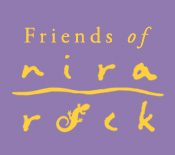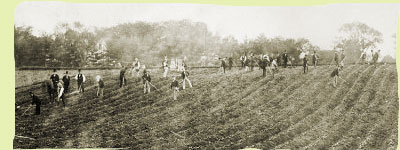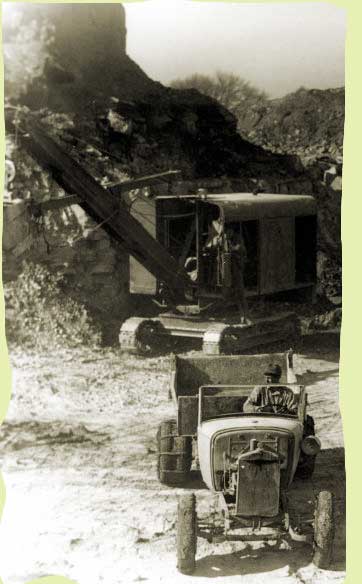Nira Rock: a brief history

|
 |
 |
 300 million years ago –
give or take a few million years – Jamaica Plain was situated squarely on the earth's
equator. Conditions were ripe for the formation of a unique kind of stone. It was made up of
small river rocks, cemented together deep inside the earth by natural mineralization. This
particular structure gave the stone the appearance of an old-fashioned, fruit-studded Christmas
pudding. Over millennia of glacial activity, surface erosion, and continental drift, these stone
formations were eventually exposed here in what is now known as Massachusetts, where they were
dubbed "puddingstone" by early settlers. The Boston basin, between the Blue Hills and the
Atlantic Ocean, is one of the few places in the world where this particular puddingstone can be
found – along with parts of Western Africa, to which the Massachusetts coast was attached
before it's long drift northward. This puddingstone is so unique, "Rox"-bury is named for it,
and it has been dubbed the "official rock of Massachusetts." 300 million years ago –
give or take a few million years – Jamaica Plain was situated squarely on the earth's
equator. Conditions were ripe for the formation of a unique kind of stone. It was made up of
small river rocks, cemented together deep inside the earth by natural mineralization. This
particular structure gave the stone the appearance of an old-fashioned, fruit-studded Christmas
pudding. Over millennia of glacial activity, surface erosion, and continental drift, these stone
formations were eventually exposed here in what is now known as Massachusetts, where they were
dubbed "puddingstone" by early settlers. The Boston basin, between the Blue Hills and the
Atlantic Ocean, is one of the few places in the world where this particular puddingstone can be
found – along with parts of Western Africa, to which the Massachusetts coast was attached
before it's long drift northward. This puddingstone is so unique, "Rox"-bury is named for it,
and it has been dubbed the "official rock of Massachusetts."
million years later, in the early 1800s, the Hyde Square area of Jamaica Plain was largely farmland. Records from that period reference farmhouses, barns, a tavern, a slaughterhouse, and – near the dividing line of the extensive landholdings of Phineas Withington and Peleg Heath – a prominent ledge of rocks. Known then as "Bleiler's Ledge," it's still the dominant landscape feature of the neighborhood: Nira Rock. Later in the same century, puddingstone became a
desirable building material. In the 1870s, Boston accepted Frederick Law
Olmsted's bid to design a sinuous system of linked city parks in the "picturesque
landscape" style.
In the early 1900s, Jamaica Plain was being
transformed from a pastoral escape into a suburb of Boston, and the Hyde Square neighborhood was
no exception. The large farms in the area were divided into small house lots, which were filled
with Queen Anne single-family houses and the triple-deckers that are still a hallmark of Jamaica
Plain's architecture. The upper meadow of Nira Rock was itself slated to become twelve tidy
house lots. Though city maps of the site still clearly show the outlines of these lots, they
were never built on. Presumably the steep climb of the terrain – and the inpenetrable
bedrock of puddingstone – made the area inhospitable to construction. Whatever the case,
Nira Rock was spared, and left as public land for future generations to enjoy.
Over the next decades, Nira Rock languished as a
forgotten, overgrown place. Its seclusion – with no abutting major roads – made it
the perfect place for young people to engage in play (or less innocent pursuits) away from the
watchful eyes of parents and police. Oral accounts from neighbors indicate that the spot was a
favorite for high school drinking, as well as Sunday-night bonfires attended "by the whole
neighborhood." In the 1970s, neighborhood children affectionately called it "Gilligan's
Island." But by the late 70s and 80s, the site took a darker turn, as much of the city was
affected by the burgeoning crack epidemic.
In the late 1980s, a number of new residential projects were developed in the Nira Rock area. Partly in response to this, Boston Natural Areas Network
(BNAN) conducted a community forum to discuss the potential utilization of a number of local
city-held properties. In addition to the creation of a neighborhood park and community garden,
this process led to the transfer of Nira Rock's ownership from the Boston Department of
Neighborhood Development to the Boston Parks Department – and its official recognition as
a protected Urban Wild.
Through a city-funded grant, BNAN initiated the recovery of Nira Rock,
including the removal of years of illegally dumped trash and debris, the installation of formal
entry gates, and the planting of native shrubs, trees and perennials. This important initiative
laid the groundwork for further improvements.
In 1990, Earthworks planted
a small orchard on the site. In 2000, a handful of neighbors began to discuss how to continue to
improve the condition of the site and address crime. Shortly thereafter, Friends of Nira Rock
was formed, and regular site cleanups were initiated. The Parks Department's Urban Wilds
Initiative embraced Nira Rock as a priority and, in 2004, COGdesign created a landscape design
for the site. In 2005, the founding member of Friends of Nira Rock received a Community Service
Award from the Boston Police Department, in recognition of her contribution to turning Nira Rock
around. Momentum grew with the award of grants and donations from several sources –
including the city as well as private and non-profit organizations – for infrastructure
improvements and ambitious native plantings.
 Today, Nira Rock is managed through a partnership
between the Urban Wilds Initiative and Friends of Nira Rock, with lots of help from our many partners and supporters. It has been transformed
from a derelict, foreboding place into a beautiful natural sanctuary for wildlife and people
alike. Regular social events like outdoor movies and climbing workshops have added a new
dimension to the site's place in the community – and there more improvements and events in the
works! Please check back regularly to see what's happening at Nira, or subscribe and we'll keep you
posted on what's coming up.
|


